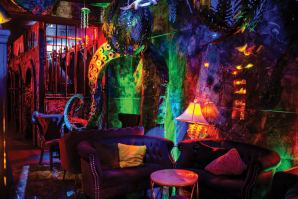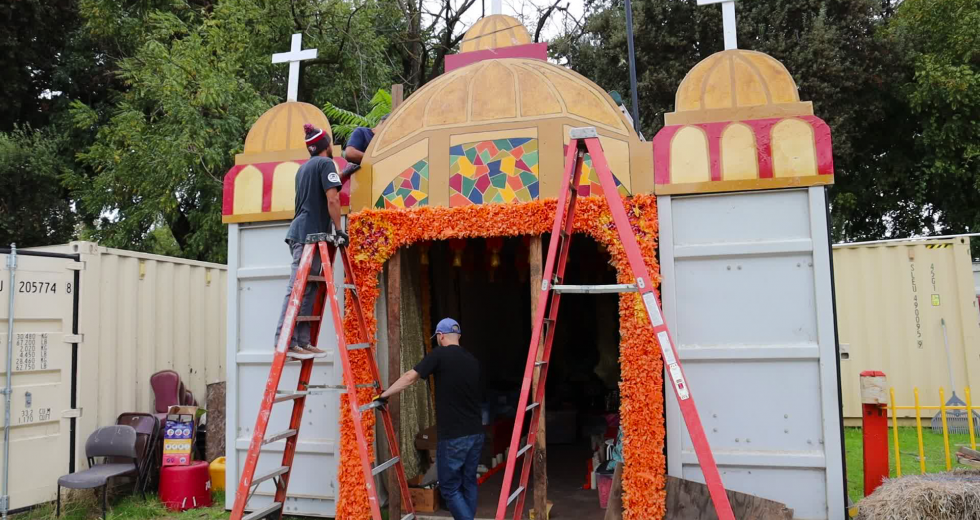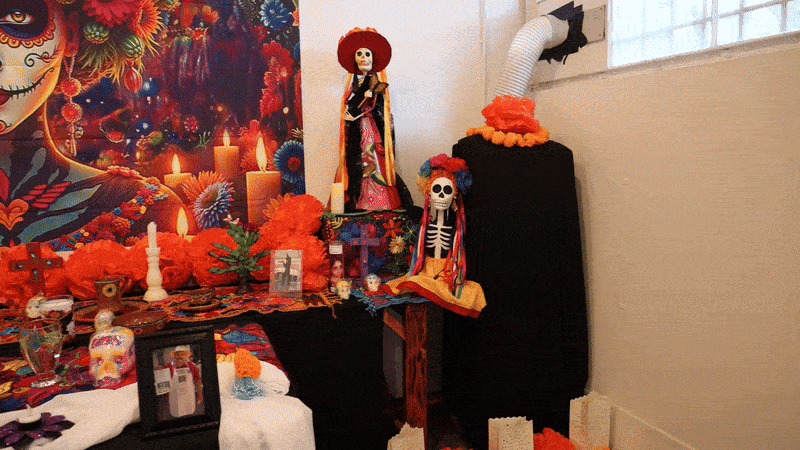Garlands of handcrafted paper and fresh marigolds drape an ofrenda, or altar, adorned with candles. The orange petals create a celestial glow as the smell of the burning copal incense permeates the air, the smoke dancing into curls as it rises. In the distance, mounds of dirt lie in rows as representational graves. For months, volunteers at the Latino Center of Arts & Culture have prepared El Panteón, one of Sacramento’s annual Día de los Muertos celebrations, which transforms 2700 Front Street’s grounds into a communal cemetery for remembrance and joy.
In response to and alongside the Chicano Civil Rights Movement of the 1970s, La Raza Bookstore opened in 1972 off of 12th and F streets. The bookstore became a community hub where artists, activists and culture bearers came together to continue and treasure cultural traditions. “This is our 16th annual (Panteón). We are expecting about 30 vendors,” says Bridgètt Rexford, LCAC’s executive director.
The center officially changed its name to the Latino Center of Arts & Culture in 2014, continuing its commitment to serve artists and communities who are marginalized across the Latino diaspora. Dia de los Muertos (the Day of the Dead) is a long-held Mexican tradition where family members honor those who have passed through ceremony, gathering and community. Families create ofrendas with photos of their loved ones, adorned with marigolds, sugar skulls, papel picado (paper banners that represent the wind), fruit and small items to celebrate and grieve their friends and family.
“Originally it started with one vendor, Yolanda’s Tamales, and just three altars. Last year, 12,000 people attended. It has expanded exponentially since then at about a thousand people per year,” Rexford says. Having joined the organization in March, she has been one of many driving forces behind the event along with various board members, artists and community members.
Related: Taste Makers: Yolanda Vega is the driving force behind the family’s expanding food brand
“The cemetery is more than an installation piece, because this year (it) is going to be open to the public. What we found is more people were interested in creating altars, and the tumbas “graves” will allow them to make their altars out there as well. So instead of 40 altars, we’ll have over 90,” says artist Ruben Reveles, who has been with the Latino Center for eight years. “In the current atmosphere, people are searching for something joyful as well as meaningful. I think that contributed to the increase in inquiries.”
This year’s El Panteón comes amid a series of event cancellations throughout the city. In September, the Mexican Cultural Center of Northern California canceled the festival portion of its celebration of Mexican Independence Day known as El Grito. Typically hosted in front of the Capitol, the event was one of the first to scale down celebrations. KCRA reported that organizers said the changes were “due to the current political climate and concerns for the safety of our community.”
For over a decade Sol Collective has served its community through activism, art and providing a safe place for people to gather. Souls of the City is typically one of Sacramento’s largest Dia de los Muertos events that takes place in old town Sacramento. Founder, Estella Sanchez of Sol Collective writes: “After more than a decade of offering Souls of the City as a free community event, the cost and staffing burden of producing something at that scale has increasingly fallen on our nonprofit.
Related: Fresh Perspectives at Sacramento’s Oldest Latinx Theater
With overall funding down this year and early planning raising community safety concerns given the national climate we made the hard decision to pause, regroup and plan for a stronger return in 2026 with the right resources in place.
Sol Collective is still hosting smaller gatherings, including harvesting marigolds and hosting sugar skull workshops. Even El Grito still gathered in solidarity despite cutting the festival portion of their event.
“It’s about gathering,” Rexford says. “As a new ED, I can’t tell you how many community members have come up to me asking if we are going to have El Panteón this year,” she added, explaining her personal reasons for moving forward with the event despite the current political climate. “With tears in their eyes, they told me they needed this. So I made the decision, along with the support of the board and our partner vendors, to move forward.”
Reveles shares his perspective on the event. “It’s not about organizations, it’s about people, the community — to see generations of kids with their grandparents making flowers, having fun, talking with each other and that’s something people need. And I want to emphasize that everyone is invited too. Death happens to all of us,” he explains. “Sometimes in American society, we don’t talk about death enough. People from all different cultures can come together. In the Mexican tradition, it’s very vibrant and colorful, it’s a celebration and a way to keep talking about them (loved ones who have passed) when sometimes people feel like they can’t.
“My mother died when I was 4 days old, and my mother that raised me has also died; a couple friends of mine died in the last couple of weeks. I’m an artist, and in my community a lot of poets, musicians have passed.”
Related: Cultural Capital: Who benefits from arts and culture in the Capital Region, and who owns it?
At the top of tiered ofrenda amongst marigolds, candles and memorabilia sits a 50-inch screen rotating through faces where Reveles has asked several community members to contribute photos of their loved one. “The screen is much bigger than the small photographs,” he says. “It’s designed to feel more heavenly. I’m a futurist artist, with a tradition of technology and earth magic, I’m creating an opening for people’s hearts and souls.”
Earlier in the year, the Latino Center lost an operational grant of $65,000 when cuts to the National Endowment for the Arts were made. As a result, they’ve had to increase ticket prices from $5 to $10, but kids are still free. They need more volunteers for the event days of Oct. 31, Nov. 1 and Nov. 2. However, they’ve had an average of 50 volunteers showing up every Thursday to make flowers, dig the tumbas and decorate their altars. The festival will open in Ceremony on Friday, Oct. 31, and go from 6 -9 p.m. The Celebrations picks up again Saturday, Nov. 1, 12-10 p.m. and on Sunday runs 12-4 p.m. ending with a closing of portal ceremony.
Larger-than-life puppets called mojigangas form a vibrant part of
Día de los Muertos parades in Mexico.

Additional celebrations happening around town include the California Museum’s “Recuerdos Ilustrados: Día de los Muertos 2025,” exhibiting until Nov. 16, and Sacramento’s Children’s Museum is hosting Día de los Muertos Community Night on Nov. 1 from 5-7p.m.
–
Subscribe to the Comstock’s newsletter today.
Recommended For You

Step Inside Sacramento’s Most Immersive Tiki Worlds
Bars like Shipwrecked and Hawthorne’s Hideout fuse fantasy, craftsmanship and cocktails for total escapism
The first sight through the door is something like an aquatic gargoyle with long fingers, smiling fangs and the scaly tail of a mercreature from the lowest depths.

Sacramento’s Waterfront Beckons Paranormal Tourists
Exploring the dark history of Old Sacramento
Paranormal tourism has been a steady draw for Sacramento’s waterfront over the years, and October is peak season for businesses that capitalize on the spooky atmosphere.

Fresh Perspectives at Sacramento’s Oldest Latinx Theater
How Teatro Espejo launches careers and enriches the community
If you pass the intersection where Sacramento’s Natural Foods Co-Op faces the food bank and walk along the light rail tracks, you’ll discover the city’s oldest Latinx and Chicano theater, Teatro Espejo.

Cultural Capital
Who benefits from arts and culture in the Capital Region, and who owns it?
Some members of the arts sector experience instability due to a lack of ownership in the creative movements they build. A year out from pandemic reopenings, city and state programs are supporting artists in unprecedented ways — but the relief is temporary.

Taste Makers
Yolanda Vega is the driving force behind the family’s expanding food brand
At 11 years old, Yolanda Vega started selling buñuelos and other local foods at street festivals around Michoacán. When she relocated to Sacramento in 1996, she did the same thing, driving around town and growing her clientele.






